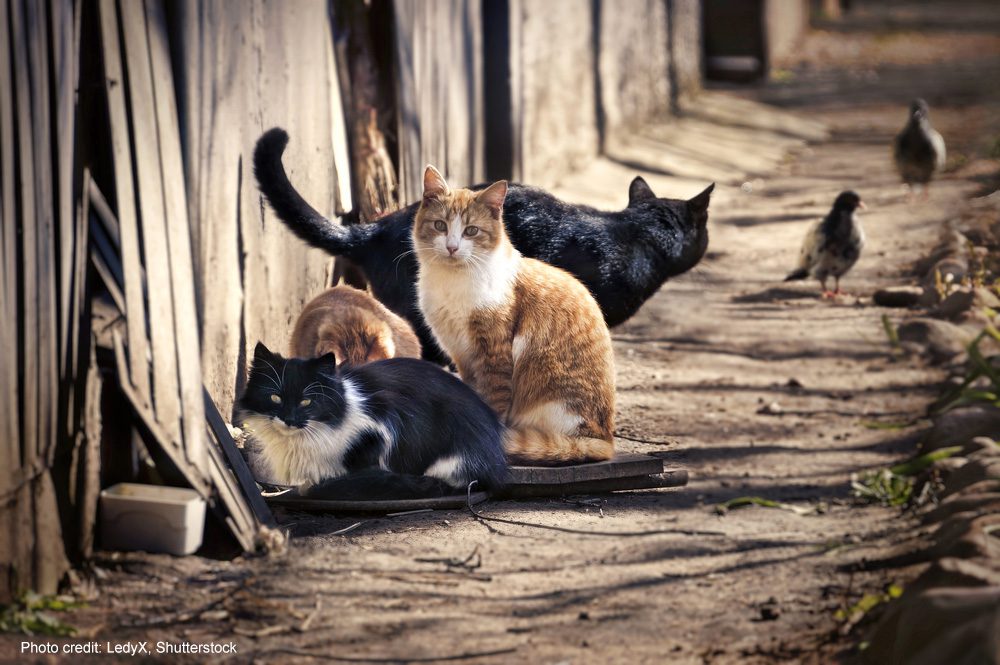
May 02, 2023 Managing Outdoor Cats
Much controversy surrounds the management of outdoor cats. Developing an agreement on the most appropriate and effective way to reduce the number of outdoor cats—by sterilization or eradication—is at the center of this longstanding dispute. Members of the wildlife conservation community argue that killing outdoor cats is necessary to save endangered species. But cat advocates maintain that sterilization via trap-neuter-return (TNR) programs are the most effective and humane method currently available to reduce free-roaming cat numbers. The origins of TNR can be traced back to the United Kingdom and Denmark in the 1950s and 1970s, respectively. TNR gained a foothold in the U.S. in the 1990s and has proliferated over the last three decades. Despite what often appears to be an unbridgeable divide over the best cat management strategies, both sides share a common goal of reducing the number of free-roaming cats.
Over the last decade, a growing body of evidence has emerged indicating that targeted TNR can effectively reduce free-roaming cat populations. Some findings from recently peer-reviewed case studies documenting the effectiveness of TNR programs include:
- The elimination of an estimated 300 cats from the waterfront in Newburyport, Massachusetts, over 17 years.
- A citizen-scientist-run TNR program in an urban Chicago neighborhood (about one square kilometer) resulted in an average decline of 54% from initial colony size and an 82% decline from peak colony size over a period of 4 to 10 years.
- Of 204 total outdoor cats enrolled in a TNR program on the University of Central Florida campus, only ten remained after 28 years.
- A 55% reduction in population (from an initial census) of free-roaming cats took place at a private residential community in Key Largo, Florida, over 14 years.
- All but a single cat was eliminated from a two-mile section of a San Francisco Bay pedestrian walking trail over 16 years after implementing a TNR program.
(For a summary of several noteworthy projects not found in the scientific literature, see “Cat Management Successes” in the August 2021 issue of WellBeing News.)
Beyond the mounting evidence indicating that appropriately implemented TNR coupled with the adoption of socialized cats does reduce outdoor cat numbers, a strong case can also be made that TNR is the most feasible option (in terms of available funds and resources). National opinion surveys indicate that the public strongly favors non-lethal management of free-roaming cats. Furthermore, the funds (approximately $4-5 billion annually in the U.S. per WellBeing International) and human capital available to animal protection organizations to address outdoor cat issues in the U.S. is far greater than the resources available to the wildlife conservation community.
Despite the considerable resources available to animal protection organizations to fund cat management programs, there is significant variation in animal protection funding from state to state. The author lives in Ohio and has analyzed the situation in this state. As of 2016, per capita income raised by animal protection organizations in Ohio is slightly less than the national average ($7.24 in Ohio compared to $8.62 nationally). Hawaii is at the top of the table, raising $16.95 per capita per annum, while Utah is at the bottom at $3.00. The number of pet cats in each state also varies. Ohio ranks 15th overall at 231 pet cats per 1,000 residents (the national average is 182 cats per 1,000 residents). Maine ranks first at 376, and New Jersey is last at 112 cats per 1,000 residents. It is still being determined why pet cat populations vary by more than 3-fold from one state to another.
Resources do not only vary by state. A 2008 survey in Ohio reported considerable variations from one county to another. A follow-up survey in Ohio in 2023 found that the resources (mainly spay/neuter services) to address outdoor cat management continue to be unevenly distributed from one county to another. For example, 24 of the state’s 88 counties had no spay-neuter resources to manage stray and feral cats. All but one of these “resource desert” counties are clustered in two areas of the state—twelve in the southeast (the Appalachian region) and eleven in the west-central part. Nearly all counties lacking spay-neuter resources are rural and sparsely populated (under 70,000 residents).
While Ohio’s five largest counties have the most (on an absolute basis) spay-neuter resources to manage free-roaming cats, competition to access cat sterilization services may be high because the available resources have to serve more than 200,000 people in the five largest counties. By contrast, in nearly half of Ohio’s counties, sterilization resources for free-roaming cats serve an average of only 26,000 residents. The ratio of residents to available resources is more favorable in smaller than larger counties. Access to spay-neuter resources that serve free-roaming cats is essential to the practice of TNR.
Likely, the uneven distribution of resources for free-roaming cats observed in Ohio is the norm rather than the exception in states across the country. Countrywide, counties with similar characteristics (e.g., population size or socioeconomic status) likely face identical resource challenges, including coping with the current widespread shortage of veterinarians available to provide needed services.
An essential step in addressing uneven resource allocation for outdoor cats in any state is developing a report identifying the gaps.
Dan Spehar is an independent researcher who works on community cat management. He has co-authored eight published peer-reviewed articles on the subject and has presented findings at national and regional conferences. He is co-founder of the Together Initiative for Ohio’s Community Cats. He has been a senior district leader volunteer for the Humane Society of the United States since 2013. He has a master’s degree in animal policy and is the author of a graduate thesis on cat management in Ohio


